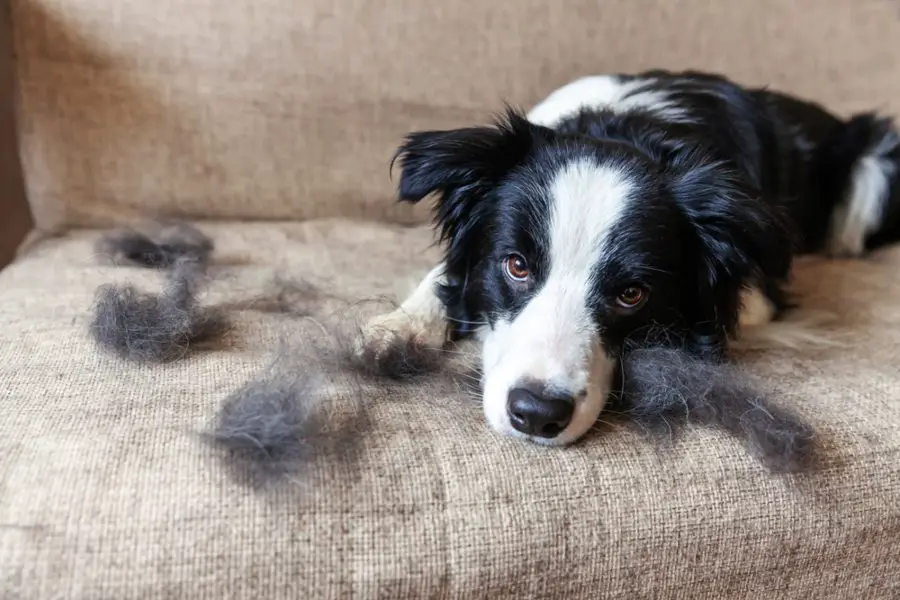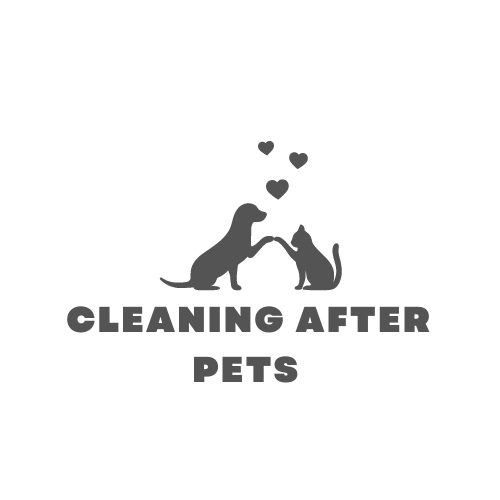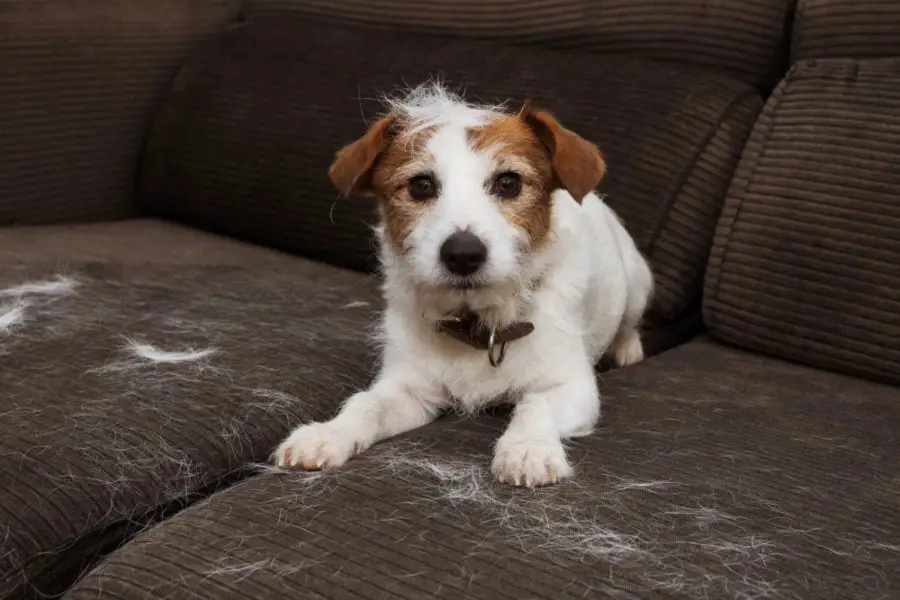Couches are the perfect comfort spot for many people; after all, when you want to sit and relax during the day, the first thought that comes to mind is the couch. In the same light, our furry friends feel the same way. Dogs love couches probably as much as we do.
And we like snuggling with them, rubbing their belly, and playing with them, which adds to the amount of fur they shed. Inevitably, you will have to deal with the issue of dog hair embedded in couch.
When left unattended, dog hair accumulates on our couches, under cushions, and settles in deeper spaces, e.g., between cushions, the space between seat cushions and the back pillows, between the inside arm and the T-seat cushion. Unfortunately, this is the same dog hair that indeed ends up lodged into our clothes, beddings, washers, and other places in the house.
All dogs will shed fur now and then, whether short curly hair dominates their coats or they are long-haired, and whether your dog loves to wag their tail or not.
The good thing is that it is possible to get rid of dog hair from our couches. You just need to know how to remove embedded pet hair from couch with minimal strain and high efficacy. Keep in mind that we have to remove hair as easily as the dogs shed to avoid the dog hair ruining our sofas.
We could also undertake recurrent preventive measures like grooming our pets, thereby getting rid of loose hair before it embeds onto your sofa. Slipcovers are also a fantastic option because they are easy to clean. However, they quite unpopular as they will “hide” your stylish couch.
This article will acquaint you with solutions on how to remove pet hair that embeds on your couch. We’ll cover every aspect of keeping your couch fur-free. If you are struggling to de-fur your couch and fear your furry mate will ruin your couch, this article is for you.
#1. Vacuum Cleaning
A vacuum cleaner with the proper attachment is an effective way to remove dog hair embedded in a couch, especially when it has powerful suction. The suction lifts all the loose hair, and at the same time, it loosens hair strands entrenched in furniture. You will find a handheld vacuum cleaner even more convenient for this task.
- Use the vacuum cleaner directing it to places where there is dog hair. Also, focus the suction on the coach’s deep-seated corners, nooks and crannies until you cannot see any hair is coming out.
- Remove cushions (if possible) and vacuum out the sides and the bottom parts where fur may hide easily.
Getting a powerful and potable wet-dry vacuum cleaner is a smart investment and a good option for the best pet hair remover for furniture. But also, preconditioning the couch’s fabric with a mixture of fabric softener and water makes it easy to remove hair with a vacuum cleaner.
You need to ensure your upholstery cannot be damaged by water before using this hack. Even more important, ensure you use a non-allergenic pet-safe detergent.
While a dog’s skin might appear tough, there is always a risk of allergic reaction when the dog comes into contact with certain chemicals, even after your couch dries out. When exposed to some cleaning agents used in formulating detergents, your dog develops an aggressive immune system response.
You can also use a squeegee to enhance the vacuuming out of the hair. Scrape the hair to one spot using the squeegee, and after that, vacuum it up.
Pro Tip: Pick any large lump of hair with your hands and throw it in a garbage bag. Do not vacuum out a large lump of hair to avoid clogging the vacuum cleaner.
#2. Rubber Gloves
Using rubber gloves is one of the simplest but reliable methods of getting rid of hair from fabric. The soft, flexible tips on rubber gloves allow you to reach deeply embedded hair, especially in nooks and crannies your vacuum cleaner cannot reach.
One of the material properties that distinguish rubber is its high friction capability, even when in contact with smooth surfaces like hair strands. This is why rubber gloves effectively remove dog hair embedded in couch and on the surface of fabric couches and furniture.
Follow these steps:
• Put on your gloves and ready them by dampening the rubber-tipped surface with little water. Damp rubber tips deal better with small stubborn hair.
- Run your hands on the part of the couch where you want to remove hair. The hair should stick on the rubber gloves because of the friction generated by the rubber tips. Repeat this step until you have removed all visible hair.
- Rinse your gloves to remove the hair after you are done and store them for use the next time you want to de-fur your couch.
You could use a pair of de-shedding gloves for your pet. Check out the best rubber gloves for removing pet hair.
#3. Lint Rollers
Lint rollers are one of the best tools to use to pull hair out of anything fabric. They are handy for homeowners looking for solutions on how to get dog hair out of couch cushions without causing any damage on the couch.
Follow these steps:
- Make rolling motions with the sticky end of the lint roller on the couch, and it will pick the hair up.
- Remove and dispose of the strip once it’s covered with enough hair and replace it with a new adhesive strip. Repeats these steps until all hair is gone.
Unfortunately, lint rollers have a short lifespan. As such, if you have plenty of pet hair, you will be forced to invest in a lot of lint rollers. A solution to this problem is to purchase extra sticky lint rollers that will grab as much dog hair with the least number of strips.
The extra sticky lint roller produces the highest bang for the buck, therefore, reducing the cost associated with this de-furring method.
#4. Brushes
Lint brushes, especially the velvet-faced lint brush and quality rubber brushes, are also a worthy consideration when you want to remove hair, fluff, and dust off your couch. While these solutions might seem simple, lint and rubber brush will give you impeccable results when used correctly.
By scraping the brush’s bristles over your couch’s surface, the strands produce static energy that attracts hair, lifting it from the sofa.
Follow these steps:
- Brush the hair off the fabric using your brush of choice. The hair strands will stick on the bristles of the brush bristles.
- Remove all the hair from the brush. Removing hair from the brush can be a tricky affair, so you may need to spare a brush for this particular purpose only.
Some people choose to use rubber soles in place of rubber brushes as a DIY solution. To use rubber soles, they have to be spotlessly clean before use. However, rubber soles are considerably less effective in removing hair from sofas compared to rubber brushes.
Furthermore, using rubber soles may be less hygienic because no one likes having shoes on the couch.
Nonetheless, the rubber in these tools creates a static force to attract hair during brushing, thereby removing the hair from the couch. As such, rubber soles might get the job done; you just have to expend a lot more energy to remove all traces of dog hair from your couch.
#5. Tape
Using tape is one of the most inexpensive and most uncomplicated methods you can use at home to clean dog fur from your couch.
Follow these steps:
- Take the tape, stretch, stick, and flatten the adhesive side on the surface of the couch with hair.
- Wait for a few seconds and pull the tape off the fabric surface of the couch.
- Dispose of the hairy tape appropriately.
On the downside, de-furring your couch with tape can be quite time-consuming, especially when dealing with a large-sized sofa or many sofas. Choose a broad tape for this purpose to cover as much surface area in one-go as possible.
I could recommend starting with scotch tape but also considering duct tape for the stubborn hair. Scotch tape is less sticky than duct tape and, therefore, less likely to remove the sticky, pesky hair.
On the other hand, duct tape is more effective on stubborn hair but may cause discoloration of your couch because it sticks firmer. Weigh your option and choose the best tools that will not damage the upholstery on your sofa.
Pro Tip: Wrap the tape around your hands so that the sticky side faces outside and then patting on the hairy areas of the couch.
Take caution not to leave the tape stuck on the couch for longer than a minute to avoid damaging the paint or other thin veneers on furniture.
#6. Using A Kitchen Sponge
Use a damp kitchen sponge you no longer use to remove the hair from the fabric. It need not be soaking wet, just a little bit wet.
- Make long wiping movements from one side to another with the abrasive side of the sponge in contact with the couch. All shed hair will gather in one place.
- Pick the hair strands and dump them in a garbage bag.
If you are dealing with stubborn hair strands stuck, you could spray a mixture of fabric softener and water to precondition and moist the surface for more manageable hair removal.
A dry sponge will also lump up hair to form hairballs, making it easy to pick and throw in the garbage bag. The denser the sponge is, the easier it will be to remove dog hair embedded in couch.

Preventions Measures: How To Keep Piles Of Pet Hair From Your Sofa
Prevention is the best form of hair control on your couch and in your house. At the end of the day, it is better to stop hair from getting to the couch in the first place rather than spend the day wondering how to remove pet hair from your sofa.
Preventive measures to keep hair from couches may include:
Replacing Fabric Couches with Leather Couches
It is a lot more difficult for dog hair to stick to leather material. In this regard, many pet owners will replace their fabric upholstered couches with leather couches. The process of how to remove dog hair from leather couches is relatively easier and straightforward. When a dog sheds on a leather couch, you can simply wipe it off your sofa.
On the other hand, removing hair from fabric couches can be a nightmare compared to leather and wooden couches. You could also consider buying a microfiber couch or any other dog hair-proof couch.
Hair Repellent Spray
Dog hair repellent spray for furniture is a form of anti-static product that makes pet hair thicker and easier to remove.
- Begin by spraying the dog hair repellent spray for furniture or any other anti-static product on pet hair and wait for it to dry. The product makes the hair larger and releases static build-up that attracts fur on the fabric.
- Use a brush or a vacuum cleaner to brush off or suck out hair or lint from the couch.
The anti-static dusting spray not only removes the electric charge holding the hair on the fabric but also lessens the probability of hair strands re-sticking on the couch.
Slipcovers And Pet Throws
You may need to use slipcovers to shield your couch from pet hair. Slipcovers for coaches are popular because they are easy to remove and wash. However, after some time, you will need to uncover the couch and de-fur the slipcover.
With the above in mind, you have to consider your couch’s shape and design when buying a slipcover. The esthetics of your living room depending on the slipcover fitting well. You do not want to end up buying a slipcover for curved-arms couches while your couch has straight arms that are as high as the back.
In some cases, the sheet cover need not cover the entire sofa. Instead, you could spread the cover where the dog likes to lay.
With a good slipcover, dog hair will fall on the cover and rather than the sofa. One downside of slipcovers is that they almost always have a negative impact on your décor. You cannot display the elegant appeal of your stylish couch.
However, if slipcovers are your only option, you can take them off when expecting company. Also, buying a slipcover means you will have to contend with washing the large, removable piece of fabric.
To reduce the impact of a slipcover on living room décor, always select a cover that can complement the overall design language and philosophy.
Regular Grooming
Grooming your dog is a brilliant way of showing affection, spending time with your pet and dramatically reducing dog fur in your living spaces.
To minimize shedding, brush your dog a few times a week to remove the loose hair. Brushing your dog ensures you catch the loose before your canine friend sheds the hair on your couch. Pet grooming and de-shedding gloves are an effective tool for this job – loose hair will stick on the gloves, which you dispose of appropriately.
Brushing your dog often is exciting to the pet; the dog will enjoy the attention. Find a spot in your house where you can brush off the loose hair without creating a mess.
Some people consider shaving their dogs once a month. On the face of it, it may seem like a good idea to keep hair off the couch. But do not go shaving your dog just yet. The practice is not recommended for many dogs, especially those with thick hair and double coats.
The fur on dogs has a temperature regulation role, and you do not want to harm your furry friend during the cold and hot seasons. You might want to keep that in mind before you shave all hair on your pet.
Conclusion: Consult Your Vet
choosing one of the aforementioned solutions depending on the materials used as upholstery on your couch, the time you have, and the extent of dog shedding. Additionally, you can use two or more solutions in case one of these solutions does not get the job done to your liking.
Do not just worry about how to remove pet hair from couch only. It is possible your dog might be suffering from a medical condition causing an excessive loss of hair. If you notice a worrisome amount of shedding, do not hesitate to visit the vet.

